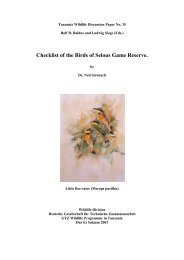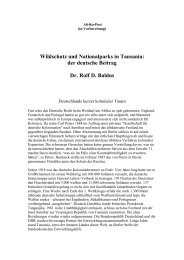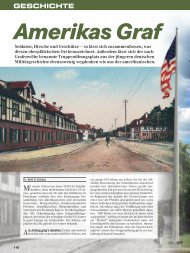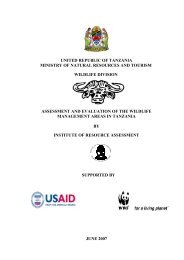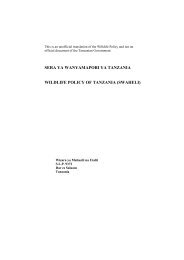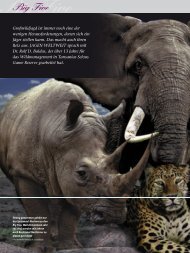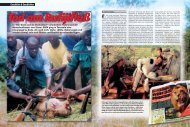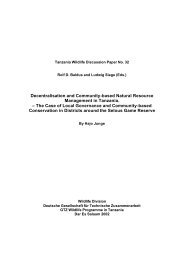African Indaba Articles - wildlife-baldus.com
African Indaba Articles - wildlife-baldus.com
African Indaba Articles - wildlife-baldus.com
You also want an ePaper? Increase the reach of your titles
YUMPU automatically turns print PDFs into web optimized ePapers that Google loves.
A total of 91 samples were collected; 29 from Dande South, 30 from Chewore North and 32 from DandeNorth. The data sets from Chewore North and Dande South are probably representative of the trophy buffalopopulations within those areas; the data set from Dande North represents just under half of the quota for thearea.The average age of the sampled buffalo was 8.01 years. The majority of the buffalo shot (76%) werebetween 6 and 8 years old; the remaining 24% <strong>com</strong>prised mostly of 9 and 10 year-olds, with less than 6% ofthe hunted population being 11 years or older. 3% of the buffalo were considered to be truly immature (5years in age).Dande South exhibited the largest proportion of “young” trophies, with 52% of the sampled quota being 7years or younger in age (25% are 6 years old). The oldest trophy is only 10 years old. Dande Northexemplified a greater proportion of older trophy animals, and contains the highest percentage (40%) of 7 - 8year-old trophies (animals in their prime). Yet there is still a relatively large percentage (25%) of youngindividuals (6 year olds) being shot. 16% were 10 years old and 6% reached 12 years. Chewore North has arelatively normal age structure within its hunted sample of trophy bulls, with the greatest number of bulls(35%) being shot at the prime age of 8 years. 16% of the trophies are 6 years old. There is however a sharpdecline in trophies of 9 years or older and a “tail” of older animals.Given the results of earlier studies, a more plausible explanation is that few 9, 10, 11, and 12 year-oldsare being shot because bulls are being taken before they reach that age. The sustainability of trophy huntingis brought therefore into question. Data on trophy ages obtained from Big Five Safaris indicate that trophyage has been relatively stable over the previous 4 years; average ages ranging from 8.7 to 9.9. Ageing ofbuffalo bulls has also been taking place in Dande North, with the average age ranging from 8 in 2001 to 10 in2002 and back to 9 in 2003. However, it has since been established that teeth had not been extractedresulting in overestimation of the actual ages. This said the data is still relevant since it provides evidence ofrelative stability in trophy age in Chewore North and Dande NorthAccording to estimated population figures from an aerial census in 2001, the offtake in all three areasexceeds the re<strong>com</strong>mended 2% pa. The estimated buffalo population of Dande North in 2001 was 4037; morerecently the same population, from visual estimates on the ground, is judged to be about 5500 animals. If thisis the case then the set quota for 2004 is just under the re<strong>com</strong>mended 2%. Although Chewore North andDande South both have large buffalo populations, the evidence suggests that the re<strong>com</strong>mended offtake of2% pa has been exceeded. It is also likely that that quota setting is affected by the different managementsystems employed between Chewore North and Dande North and South.It would appear that the average trophy scores (from Chewore North, Dande North and Dande South) aresatisfactory for the majority of clients. Whether this is really the case or not is an interesting question. Thenature of the desired trophy changes somewhat depending on the client nationality; European clients,especially German and Austrian, tend to prefer “character” trophies, which are usually older animals, theemphasis being on trophy individuality and not size or score. American clients, (60% of the safari client) areinclined towards hunting individuals for their trophy size.But hunting and trophy selection is not an exact science. Ultimately a client will shoot the trophy which, inhis mind, is best, and has the backing opinion of the professional hunter, who after all is the client’s “visualmeasurement method.Hunting buffalo is no easy task, and the absence of any truly mature animals could be attributed to the“pressures” of hunting and ultimately, chance. The “pressures” of hunting involve limited time frames, fussyclients, “co-operative” buffalo and of course an element of luck. Whilst these previous two scenarios arepossible, the most obvious factor explaining the lack of old trophy buffalo is simply that there are very few oldbuffalo within the population. Death by natural means is more likely to occur as buffalo age, and is usuallyaround 14 years or older amongst unexploited (protected) wild buffalo populations.The average Rowland Ward (RW) score was 36.98 inches with “40 inch” buffalo considered the benchmark for a good quality trophy. The average SCI score was 96.26 inches, just short of the bench mark SCItrophy score of 100 inches.Correlation between trophy size and animal age using the RW method indicate that scores decreaseminimally with age. The SCI scoring method indicates in contrast the possibility of a strong relationship121



